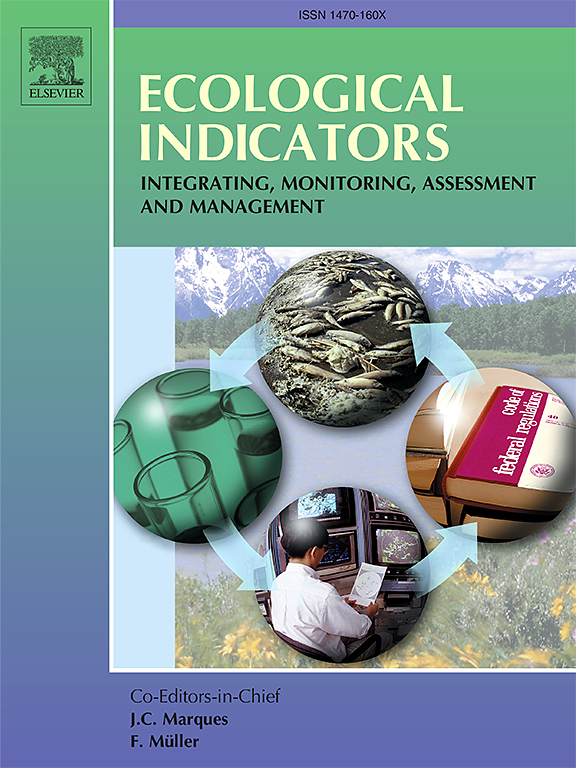Response and resilience of farmland ecosystems to flash drought in China
IF 7
2区 环境科学与生态学
Q1 ENVIRONMENTAL SCIENCES
引用次数: 0
Abstract
Flash droughts negatively impact agricultural ecosystems and threaten food security due to their rapid development and unpredictability. This study utilized reanalyzed data from 2000 to 2018 and employed a comprehensive index method to identify two flash droughts: heat wave flash droughts (HWFD) and precipitation deficit flash droughts (PDFD). We analyzed the spatiotemporal evolution of these droughts across China’s farmland ecosystems and investigated the response patterns of these ecosystems to both types of flash droughts using response frequency and response time metrics. Our findings indicate that between 2000 and 2018, flash droughts were most frequent in June, with the highest frequency and most extended duration occurring in summer and the lowest in autumn. Spatially, HWFD frequency was highest in the Loess Plateau, with durations of 4.4 and 5.0 octads, while PDFD was most frequent in the Gansu-Xinjiang (GX) and Huang-Huai-Hai (HHH) regions. Over time, there was a decrease in the frequency and duration of flash droughts. The study revealed that Net Primary Productivity (NPP) generally exhibited a low response frequency to flash droughts, with PDFD showing a higher response frequency and a shorter response time than HWFD. Irrigated farmland showed higher NPP response frequencies, particularly in the HHH region, whereas rainfed farmland demonstrated stronger resilience to flash droughts. This research provides theoretical support for developing flash drought early warning systems and drought mitigation policies, significantly contributing to food security in China’s farmland ecosystems.
中国农田生态系统对突发性干旱的响应与恢复力
突发性干旱由于其发展迅速和不可预测性,对农业生态系统产生负面影响,并威胁粮食安全。本研究利用2000年至2018年的重新分析数据,采用综合指数法确定了两种突发性干旱:热浪突发性干旱(HWFD)和降水不足突发性干旱(PDFD)。分析了中国农田生态系统干旱的时空演变特征,并利用响应频率和响应时间指标研究了中国农田生态系统对两类突发性干旱的响应模式。我们的研究结果表明,在2000年至2018年期间,6月份的突发性干旱最为频繁,夏季频率最高,持续时间最长,秋季最低。从空间上看,黄土高原区HWFD频率最高,持续时间分别为4.4和5.0 8ads,而甘新疆(GX)和黄淮海(HHH)地区PDFD频率最高。随着时间的推移,突发性干旱的频率和持续时间有所减少。研究表明,净初级生产力(NPP)对突发性干旱的响应频率普遍较低,其中PDFD的响应频率高于HWFD,响应时间较HWFD短。灌溉田的NPP响应频率更高,特别是在HHH地区,而雨养农田对突发性干旱表现出更强的抵御能力。该研究为建立突发性干旱预警系统和制定干旱缓解政策提供了理论支持,对中国农田生态系统的粮食安全具有重要意义。
本文章由计算机程序翻译,如有差异,请以英文原文为准。
求助全文
约1分钟内获得全文
求助全文
来源期刊

Ecological Indicators
环境科学-环境科学
CiteScore
11.80
自引率
8.70%
发文量
1163
审稿时长
78 days
期刊介绍:
The ultimate aim of Ecological Indicators is to integrate the monitoring and assessment of ecological and environmental indicators with management practices. The journal provides a forum for the discussion of the applied scientific development and review of traditional indicator approaches as well as for theoretical, modelling and quantitative applications such as index development. Research into the following areas will be published.
• All aspects of ecological and environmental indicators and indices.
• New indicators, and new approaches and methods for indicator development, testing and use.
• Development and modelling of indices, e.g. application of indicator suites across multiple scales and resources.
• Analysis and research of resource, system- and scale-specific indicators.
• Methods for integration of social and other valuation metrics for the production of scientifically rigorous and politically-relevant assessments using indicator-based monitoring and assessment programs.
• How research indicators can be transformed into direct application for management purposes.
• Broader assessment objectives and methods, e.g. biodiversity, biological integrity, and sustainability, through the use of indicators.
• Resource-specific indicators such as landscape, agroecosystems, forests, wetlands, etc.
 求助内容:
求助内容: 应助结果提醒方式:
应助结果提醒方式:


